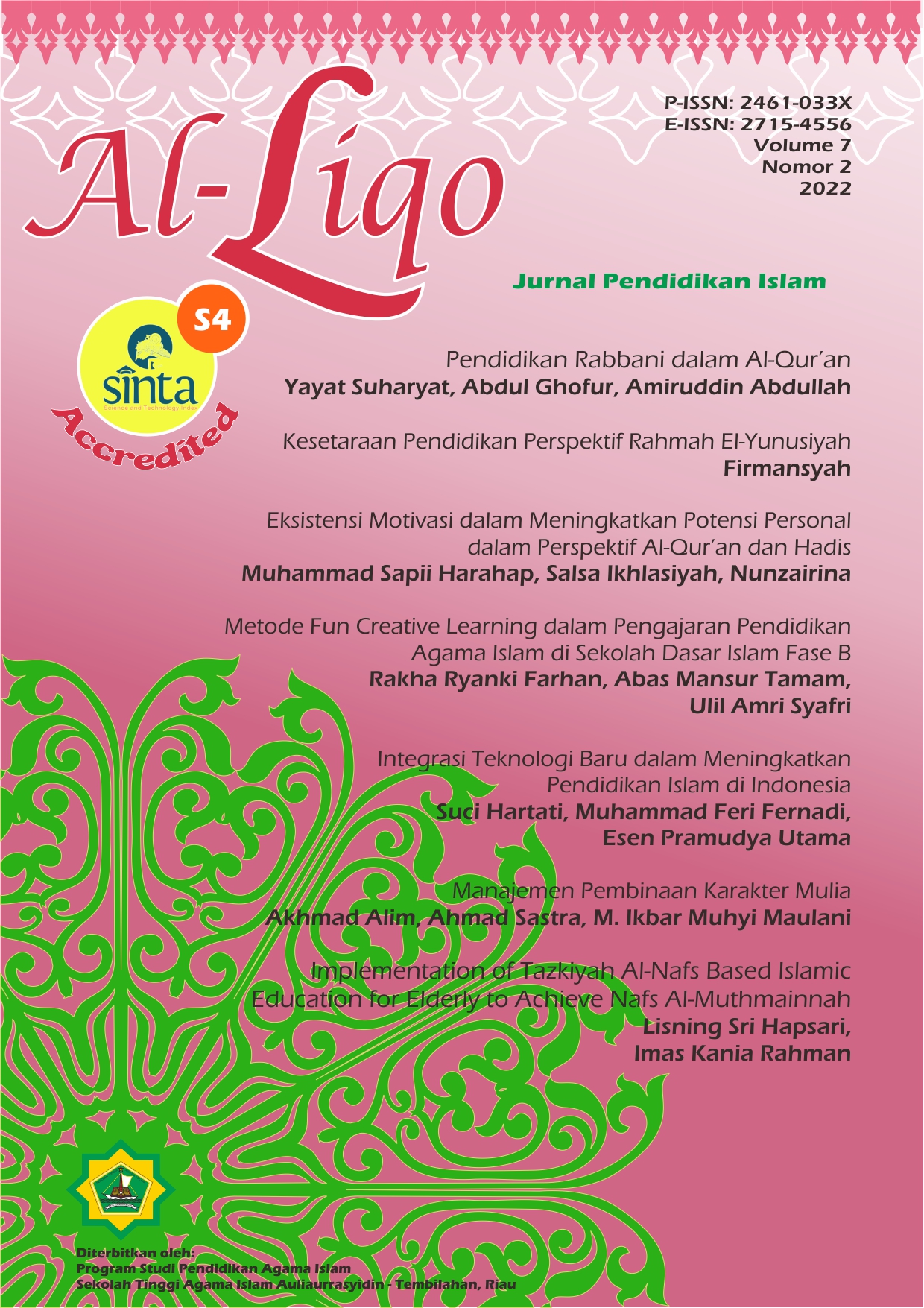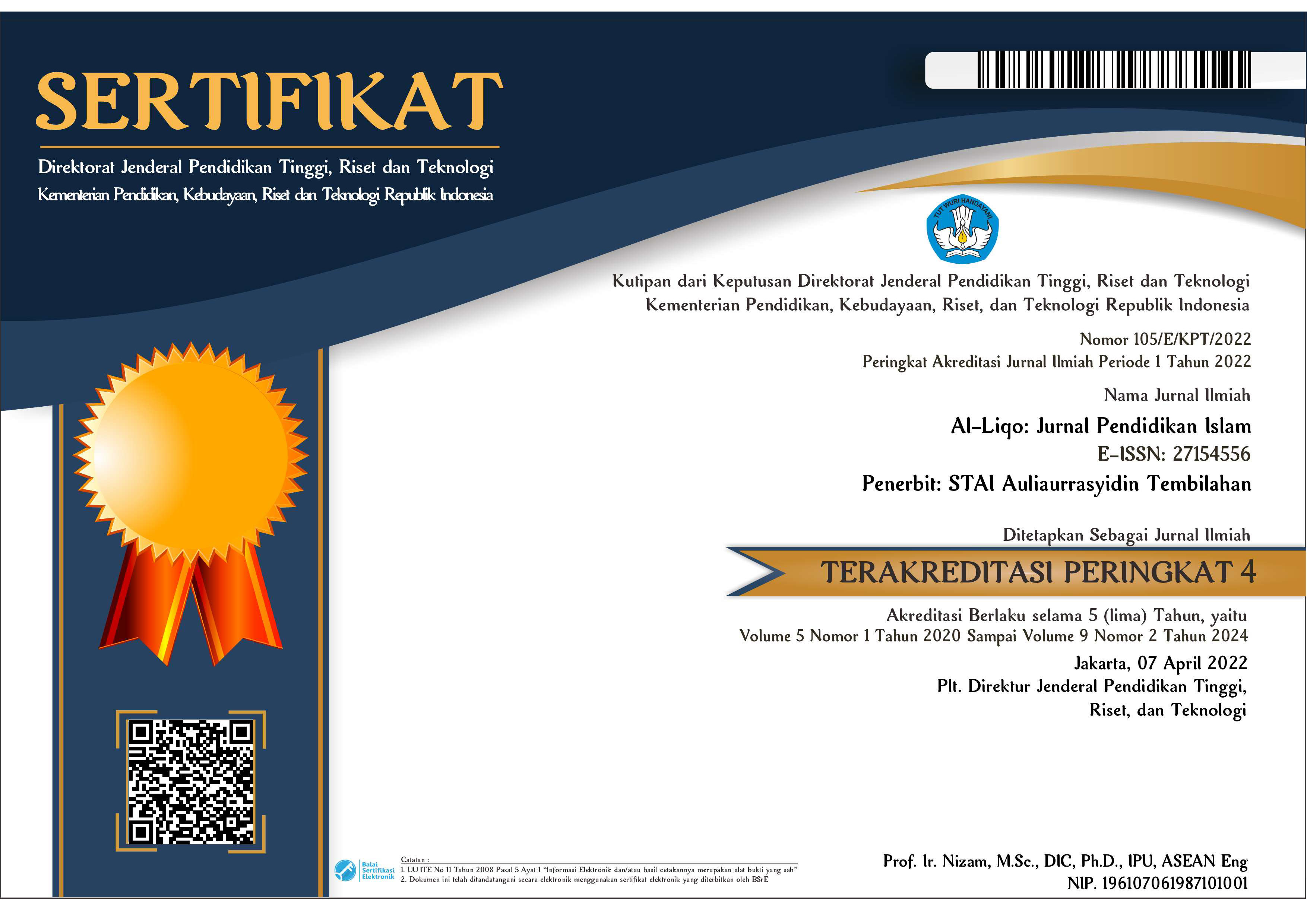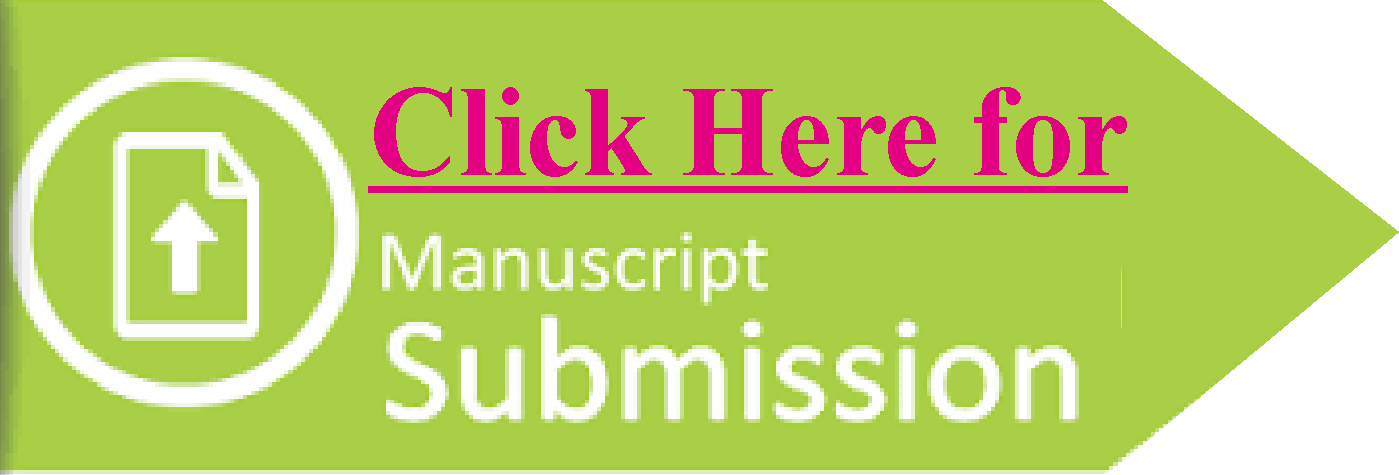Metode Fun Creative Learning dalam Pengajaran Pendidikan Agama Islam di Sekolah Dasar Islam Fase B
DOI:
https://doi.org/10.46963/alliqo.v7i2.578Keywords:
Fun Creative Learning, Islamic Religious Education, Elementary SchoolAbstract
The Fun Creative Learning method is a fun learning strategy to create an effective learning environment, designed in such a way as to provide an atmosphere that is full of fun and most importantly not saturating and boring. The fun creative learning method is an easy way to educate early childhood because it suits their needs and stage of development. This research aims to find out the fin creative learning method applied at the 4th grade level of Islamic Elementary School between SDIT Al-Hidayah Bogor and SDIT SUIS (Sekolah Unggulan Islam) Bogor. As well as formulating a Fun Creative Learning Method that is extracted from the main sources of Al-Qur'an and As-Sunnah, and will be enriched with the thoughts of experts on the method. This research is a type of qualitative and field research. This research is descriptive in nature by taking the object of study at SDIT Al-Hidayah Bogor and SDIT SUIS Bogor. The data collection techniques used in this research are documentation, informant interviews, observation, and focus group discussion (FGD). The results obtained from this research are a fun creative learning method according to educational experts which contains teaching techniques from each method given.
Downloads
References
Agus Miftakus Surur, Moch. Erwin Wahyudi, & M Anggi Mahendra. (2020). Upaya Meningkatkan Motivasi Belajar Siswa melalui Metode Artikulasi Sebagai Perangsang Timbulnya Kompetensi. Journal Focus Action of Research Mathematic (Factor M), 2(2), 141–156. https://doi.org/10.30762/factor_m.v2i2.2282
Ahmad Khaerudin. (2013). Penerapan Pembelajaran Biologi Berbasis Nilai Imtaq Untuk Meningkatkan Hasil Belajar Siswa Konsep Pencemaran Lingkungan Kelas X Di Sman 5 Cirebon [IAIN Syekh Nurjati]. http://repository.syekhnurjati.ac.id/1726/
Aryani, N. (2015). Konsep Pendidikan Anak Usia Dini Dalam Perspektif Pendidikan Islam. 1(2).
Darusman, R. (2014). Penerapan Metode Mind Mapping (Peta Pikiran) Untuk Meningkatkan Kemampuan Berpikir Kreatif Matematik Siswa SMP. Infinity Journal, 3(2), 164. https://doi.org/10.22460/infinity.v3i2.61
Destri Anggaraini. (2017). Nilai-Nilai Pendidikan Islam Yang Terkandung Dalam Kisah Nabi Nuh As. Uin Raden Intan Lampung.
Hamzah B. Uno, N. M. (2011). Belajara dengan Pendekatan PAILKEM: Pembelajaran Aktif, Inovatif, Lingkungan, Kretaif, dan Menarik (Oktober, Vol. 1). Bumi Aksara.
Luthfi, M. F. (2014). Pembelajaran Menggairahkan Dengan Ice Breaking. 1.
Muslim, S. R. (n.d.). Pengaruh penggunaan metode student facilitator and explaining dalam pembelajaran kooperatif terhadap kemampuan pemecahan masalah matematik siswa SMK di Kota Tasikmalaya.
Priyanto, A. (2020). Pendidikan Islam dalam Era Revolusi Industri 4.0. J-PAI: Jurnal Pendidikan Agama Islam, 6(2). https://doi.org/10.18860/jpai.v6i2.9072
Putri, A. A. (n.d.). Nilai-Nilai Edupreneurship Pada Fun Learning Dalam Membangun Pendidikan Islam.
Ruwaida, H. (2019). Proses Kognitif dalam Taksonomi Bloom Revisi: Analisis Kemampuan Mencipta (C6) Pada Pembelajaran Fikih Di MI Miftahul Anwar Desa Banua Lawas. Al-Madrasah: Jurnal Pendidikan Madrasah Ibtidaiyah, 4(1), 51. https://doi.org/10.35931/am.v4i1.168
Downloads
Published
Issue
Section
License
Copyright (c) 2022 Rakha Ryanki Farhan, Abas Mansur Tamam, Ulil Amri Syafri

This work is licensed under a Creative Commons Attribution-ShareAlike 4.0 International License.
Authors who publish with this journal agree to the following terms:
1. Copyright on any article is retained by the author(s).
2. The author grants the journal, right of first publication with the work simultaneously licensed under a Creative Commons Attribution shareAlike 4.0 International License that allows others to share the work with an acknowledgment of the work’s authorship and initial publication in this journal.
3. Authors are able to enter into separate, additional contractual arrangements for the non-exclusive distribution of the journal’s published version of the work (e.g., post it to an institutional repository or publish it in a book), with an acknowledgment of its initial publication in this journal.
4. Authors are permitted and encouraged to post their work online (e.g., in institutional repositories or on their website) prior to and during the submission process, as it can lead to productive exchanges, as well as earlier and greater citation of published work.
5. The article and any associated published material is distributed under the Creative Commons Attribution-ShareAlike 4.0 International License







2.png)



